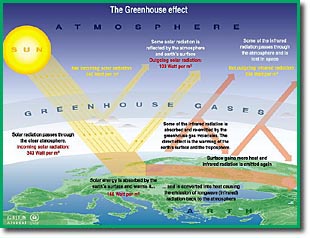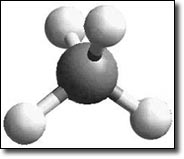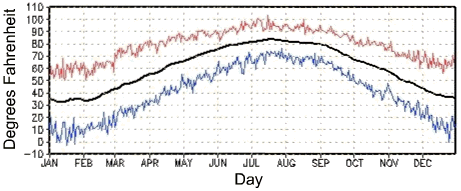The Greenhouse Effect
The greenhouse effect is a highly beneficial process where the planet is warmed by greenhouse gases helping to trap some of the radiation that would have otherwise escaped back into space. Without the greenhouse gases the surface temperature of the planet would be an average –18 °C (0 °F)! Chilly.
Greenhouse Gases
Greenhouse Gases are gases (in the atmosphere) that will absorb infrared radiation (learn more about the electromagnetic spectrum). Naturally released greenhouse gases include: water (H2O), carbon dioxide (CO2), methane (CH4) & nitrous oxide (N2O) (a.k.a. laughing gas). Ultra Violet radiation (UV) will penetrate the atmosphere and a portion will be absorbed by the surface of the planet. When radiated back into the atmosphere it will be in the form of Infrared radiation (IR), thus some of this IR radiation will be absorbed by greenhouse gases. Being a dumb molecule they don’t know which is up or down so after “doing their thing” they get “tired” and re-emit the IR radiation, a portion of which goes back to earth warming the planet. (Click here or on the molecule to see the molecule "Doing its thing".)
Source: United Nations Environment Programme /
GRID-ArendalThe greenhouse effect works because of IR radiation coming from the surface of the planet and IR absorbing molecules in the atmosphere. They absorb then emit IR in all directs a portion going back to the earth surface. Click here or on the image to see an enlarged view.
A molecule of Methane.Providing the concentrations of the greenhouse gases remain the same, then other than normal seasonal temperature fluctuations the planet will have a relatively stable temperature year to year. Of course there are natural cycles in place that both remove and replace these greenhouse gases in the atmosphere.



